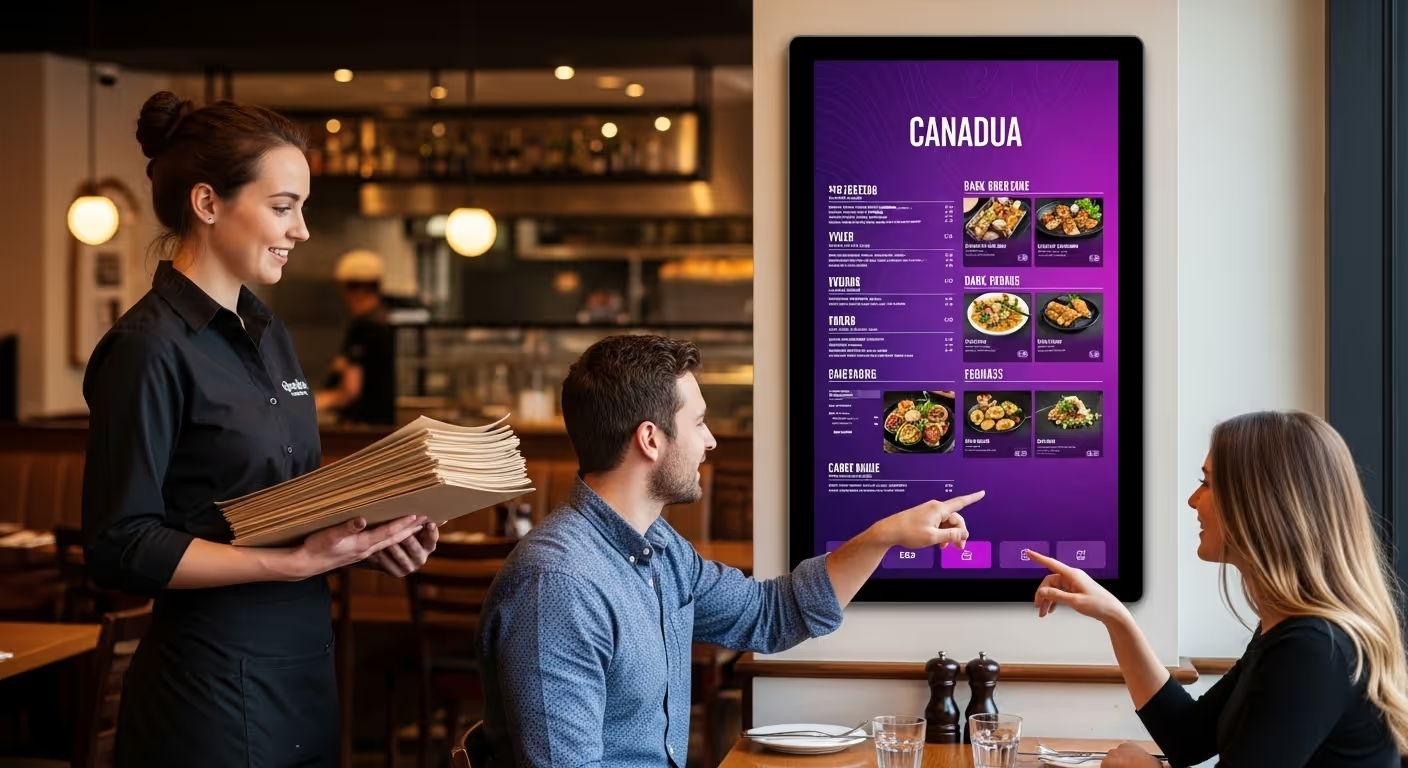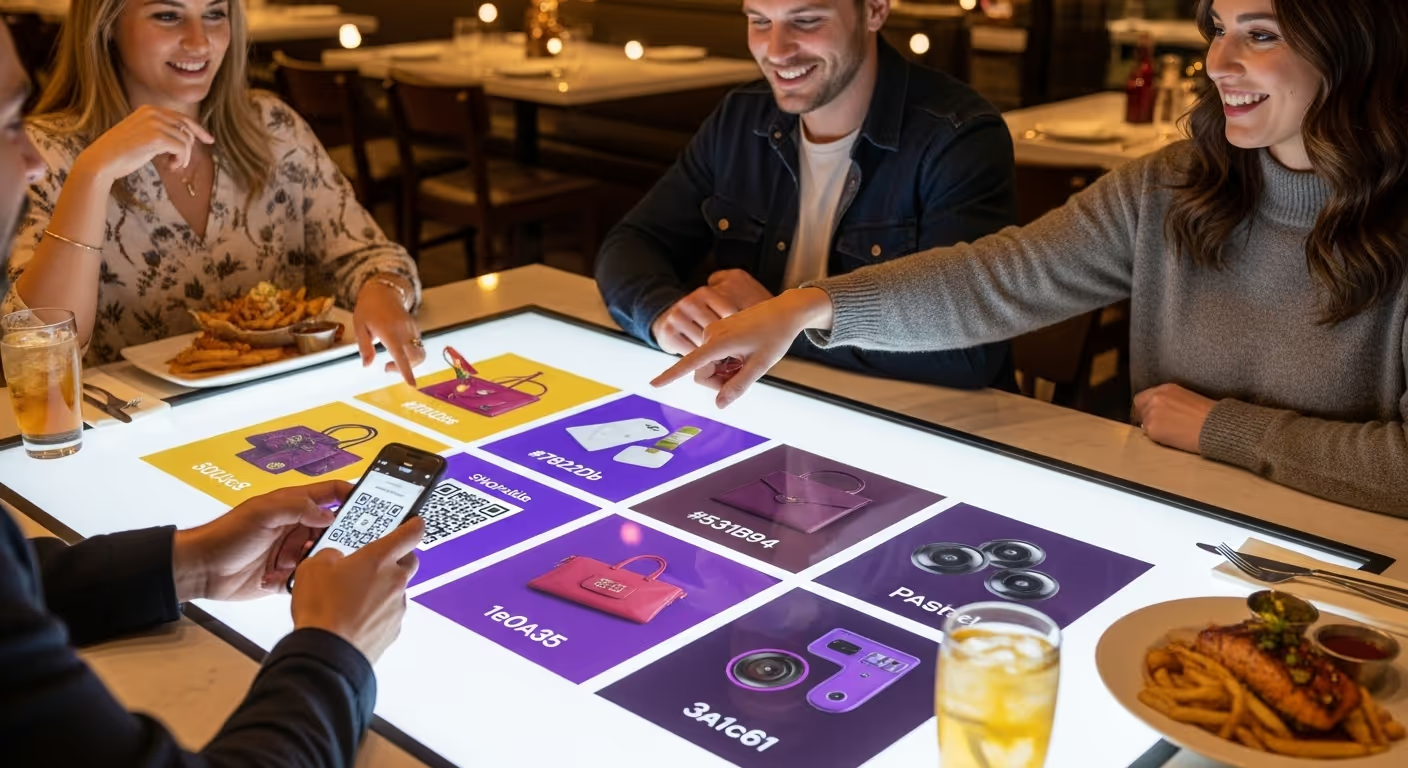What is DOOH advertising?
Digital Out of Home (DOOH) advertising refers to digital screens placed in real-world environments. Unlike traditional posters or billboards, DOOH ads are dynamic, measurable, and can be updated in real time. In restaurants, DOOH often means tabletop screens that show menus, promotions, and brand campaigns directly at the guest’s seat.
Why restaurants in Canada are turning to DOOH
Restaurants across Canada face rising costs, staffing challenges, and the need to create memorable guest experiences. DOOH technology addresses these challenges by:
- Reducing printing costs with digital menus
- Helping staff upsell with on-screen promotions
- Bringing in new revenue from advertisers
- Enhancing the dining experience with interactive features
Boosting sales with targeted promotions
One of the strongest benefits of DOOH in restaurants is its ability to display promotions that match the time of day or section of the venue. A lunch crowd might see quick meal combos, while evening guests could be offered dessert or cocktail specials. This level of targeting keeps screens relevant and increases the likelihood of upsells.
Real example: dessert sales growth
A Canadian bar that introduced DOOH screens saw dessert sales rise by 18% within the first few weeks. The secret was timing — desserts were promoted right after main dishes were ordered, creating a gentle nudge at the right moment.
Improving guest experience
DOOH isn’t just about ads. For diners, the screens add convenience and engagement. Guests can browse menus with clear photos, call staff without waving across the room, or request the bill with a simple tap or QR scan. These features make dining smoother and leave guests with a better impression of the restaurant.
Impact on staff
Servers benefit too. When guests can handle small requests themselves, staff have more time to focus on hospitality and upselling. In many cases, tip values even increase — one venue reported a 27% lift in average tips after introducing table screens.
Extra revenue from advertisers
Another powerful aspect of DOOH in restaurants is ad revenue. Brands looking to connect with Canadian consumers invest heavily in digital out of home. By placing campaigns directly on restaurant tables, advertisers gain long dwell times — often over one hour per visit — while restaurants receive a share of the ad income.
How much can a restaurant earn?
Depending on location and traffic, Canadian restaurants can see $500–$1,200 per month in passive revenue from tabletop ads. That income alone can offset system costs, making DOOH not just a guest-experience upgrade but also a financial advantage.
Case study: Adidas campaign
When Adidas tested DOOH in Canadian venues, the results showed how powerful the format can be. Over 80% of diners found the campaign more interesting compared to traditional ads, and brand recall doubled versus static posters. For restaurants hosting the campaign, it meant strong engagement without interrupting the dining flow.
DOOH and real-time targeting
Modern DOOH systems in Canada don’t rely on static loops. Campaigns can adapt to:
- Weather: promoting hot drinks on cold days or refreshing beverages during a heatwave
- Sports events: showing campaigns linked to live games during viewing hours
- Dayparts: serving different ads at lunch versus dinner
This flexibility makes each impression more relevant and valuable.
Reducing print and operational costs
Restaurants spend thousands every year on reprinting menus and promotional materials. DOOH screens replace much of this printing, updating menus instantly with no extra cost. Over time, this reduction in printing can add up to significant savings while supporting sustainability goals.
Why Canada is a strong market for DOOH in restaurants
Canadian diners spend longer at tables compared to many other markets, averaging more than an hour per visit. This long dwell time makes DOOH particularly effective in Canada, giving advertisers a full 60 minutes or more to reach guests. For restaurants, it means more opportunities to influence orders and generate incremental revenue.
How restaurants can get started
Adopting DOOH is straightforward. Most providers handle installation, content setup, and support. Restaurants only need to provide menu items, promotions, and brand guidelines. Once deployed, the system runs largely on its own, cycling between menus, promos, and ad content. With proper targeting and creative, the screens quickly start to pay for themselves.
Key takeaways
- DOOH brings in both sales growth and ad revenue
- Guests enjoy convenience and clear digital menus
- Staff save time and often receive higher tips
- Canadian market conditions make DOOH highly effective thanks to long dwell times
Your next step
For Canadian restaurants, DOOH advertising is no longer just an experiment — it’s becoming a competitive edge. By combining guest-focused features with measurable ad revenue, restaurants can strengthen their business while offering diners a modern, interactive experience.






.svg)
.svg)


